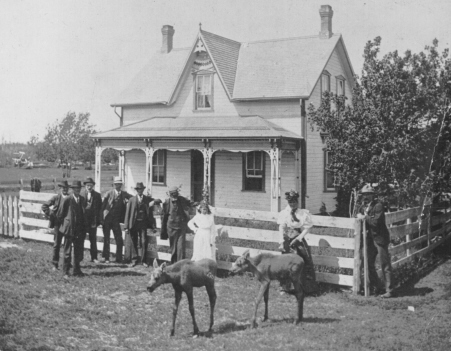This Website is owned and maintained by the Keeseekoowenin First Nation History Committee and published under the authority of the Chief and Council of Keeseekoowenin Ojibway First Nation.
The images and text contained in this website are the property of the Keeseekoowenin Ojibway First Nation
©Keeseekoowenin 1998
Page 2
 |
| Glen Campbell, his wife Harriet (nee Burns) and their daughter Mary. Photo taken at their new homestead at Big Grass near Gilbert Plains, Manitoba |
Glen stared farming in the Big Grass country of Gilbert Plains. He built a fine house and was soon farming in a big way. He had men work for a long time, Gilbert Ross, Henry Johnstone, Billy Gardener were the main farm hands. Glen was getting interested in politics and in 1903 became a Member of Parliament for the Dauphin riding. He became a very busy man between farming and House of Commons in Ottawa. When Glen was on the Mercheston Ranch with his father, he married Harriet Burns, a daughter of Chief Moses Burns. Glen and Harriet's children were:
Jack - married Dooly Turner
Eleanora - married Will Knott
Christine - married Jack Waddy
Mary - married AustenHis native fiends called him Nenabush, after a character in the Indian stories that was told by children and adults.
Glen loved horses and always rode a fine horse. At the time of the Mercheston Ranch, the horse was the main means of transportation. In the mid summer was the time of sports where horse races were the order of the day at places like Strathclair, Rapid City, Carberry, Moosomin.
When Glen Campbell left the House of Commons he became Head of the Dept. of Indian Affairs. He took a keen interest in this job. He worked very hard at it.
In the early summer of 1910 Glen's wife Harriet became ill, she was taken over the Mountain to the Riding Mountain Ranch were her sisters could look after her, it was there she died. She was buried in the Rev. George Flett's mission cemetery near her father's grave. About two years after this, Glen sold his farm to Joe Berry and Glen moved to Winnipeg and you did not see much of Glen around Riding Mountain after that. When World War I broke out Glen became Commanding Officer Lt. Col. Glen Campbell of the 107th overseas Battalion. The Timber Wolf was their badge. Walter Scott, Bill Canada of Sandy lake, John Brandon of Waywayseecappo did the recruiting for the regiment. There were quite a few native boys who enlisted from the Keeseekoowenin/Okanase band, two Sutherland boys, two Flett boys, Ed Gardippy, joined overseas. When the regiment got ready for France, among the one's that failed the physical examination were Walter Scott, and John Turner. They were sent home. Glen being officer Commander went to France with his regiment. As winter came on, Glen took sick and died in France.
Now there was a lot of stories about this man, some were not true. He was a very colourful and did some remarkable things. One writer said Glen walked three thousand miles on snowshoes. This was Robert Campbell who snowshoed from Yukon to Fort Garry, not Glen.
Glen did ride a young moose. They were taking a herd of cattle over the old Riding Mountain Trail in the heavy timber. The trail was very narrow. The cattle bunched close and there was a young moose jammed among the cattle. Glen spurred his horse up to the moose, he jumped on the moose's back and rode him till there was no room to get away. Glen grabbed a branch and yelled as he rode the moose.
{Page 1} {Page 2}
